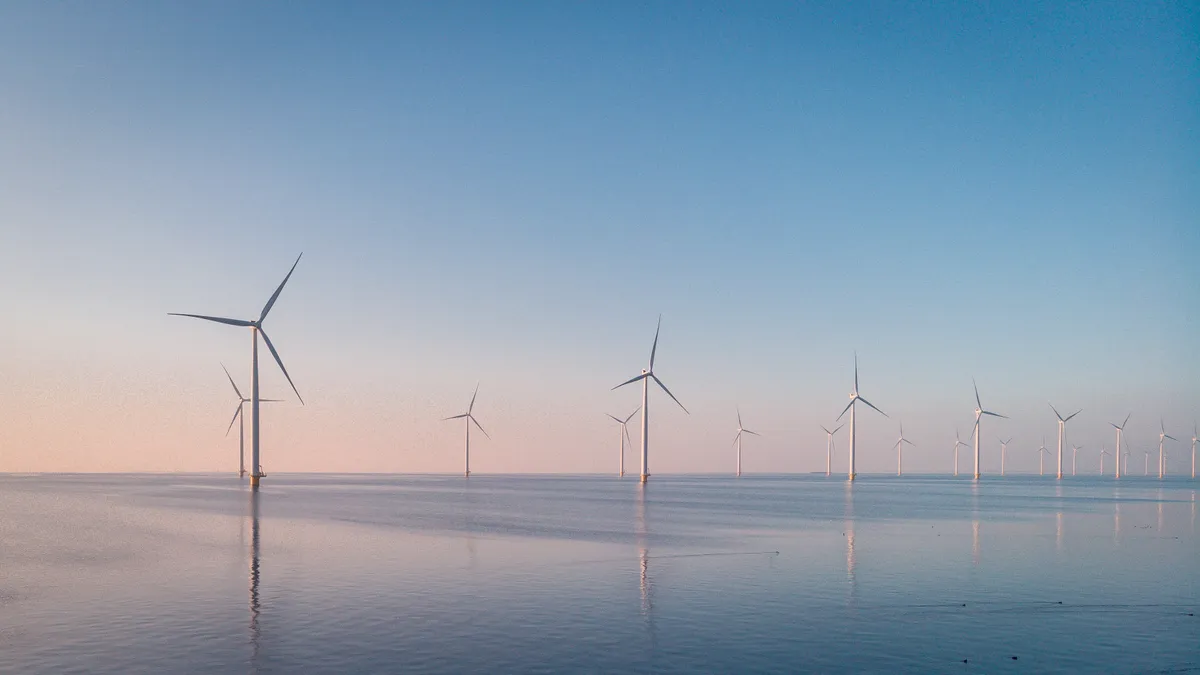Dive Brief:
- The Bureau of Ocean Energy Management on Wednesday announced a draft programmatic environmental impact statement assessing five offshore wind lease sites off the coast of California and suggesting potential measures to mitigate enviromental, wildlife and other impacts.
- The PEIS comes a week after the re-election of President-elect Donald Trump, who said at a May rally that he would issue an executive order to “make sure that [offshore wind] ends on day one.” California regulators have set a goal of deplying 25 GW of offshore wind resources by 2045.
- BOEM posting the PEIS initiated a 90-day comment period for stakeholders who want to provide feedback. Comments are due Feb. 12.
Dive Insight:
The California Energy Commission is aiming to deploy 2 GW to 5 GW of offshore wind by 2030, then ramp up deployment over the next 15 years, according to a strategic plan released in June.
The five Humboldt and Morro Bay lease areas total over 373,268 acres and contain a potential 4.6 GW in capacity. Located offshore California’s north and central coasts, they were the first lease areas identified offshore the state and auctioned by BOEM in 2022.
“This is only the second time BOEM has conducted a regional analysis of offshore renewable energy development and operations over multiple lease areas,” BOEM said in a Wednesday release. “BOEM decided to take this additional step to complete a PEIS because of the relatively close proximity of the five lease areas and the timing of when BOEM expects to receive future project plans for review.”
“This report is good news and another important step forward for floating offshore wind in California,” industry coalition Offshore Wind California said in a release. The group said the review “will help ensure timely decisions can be made to advance floating offshore wind for the Golden State and facilitate adoption of mitigation measures to minimize impacts and protect local communities, marine life, and the environment.”
The PEIS analyzed three scenarios: Alternative A, in which development does not occur in the Humboldt and Morro Bay lease areas; Alternative B, in which development occurs “without the application of any mitigation measures that could avoid, minimize, mitigate, and monitor those impacts”; and Alternative C, in which development occurs along with mitigation measures.
The mitigation measures BOEM suggested in Alternative C include passive acoustic monitoring, which measures construction sound levels and monitors the presence of vocalizing marine species like whales, as well as avoiding the use of the greenhouse gas sulfur hexafluoride and a vessel speed limit.
In September, President-elect Trump remarked at a rally that offshore wind generation was making whales "crazy" and causing dead whales to wash ashore on a weekly basis, the BBC reported. The PEIS noted that anticipated vessel traffic in the lease areas is high, “and the composition of such traffic is diverse,” but even without mitigation efforts, “mortality risk is low and not expected” for toothed whales in the area.
When it comes to noise, BOEM said, “behavioral disturbance is possible with higher-amplitude sources like bubble guns, some boomers, and high-power sparkers, but unlikely with mitigation (clearance zones, shutdowns, etc.). These sounds could cause temporary acoustic masking in low- or mid-frequency cetaceans (e.g., sperm whales) but would not cause behavioral disturbance due to their low source levels and intermittent use.”
When comparing the three alternatives, BOEM generally found that offshore wind development – even without mitigation – could benefit the local environment, citing the associated emissions reductions. Though BOEM said offshore wind development poses risks to native animals like bats, birds and sea turtles, the agency added that a scenario where no development occurred in the lease areas meant those animals would continue to be harmed by existing environmental trends.
“Mitigation measures under Alternative C may reduce impacts on bats in the offshore environment, though the extent of any reduction would depend on project-level detail not available at the programmatic stage,” BOEM said.
BOEM said that the Alternative B option “would have impacts on mysticetes, odontocetes, pinnipeds, and fissipeds, with potentially beneficial impacts on odontocetes,” which includes toothed whales and dolphins, “and pinnipeds,” which includes seals and sea lions, “though such benefits may be offset by increased entanglement risk with [offshore wind] structures/moorings.”
When it comes to birds, BOEM said, “operation of the offshore [wind turbines] would pose the largest risk and could lead to long-term impacts (mortality and displacement),” but both alternatives B and C “could result in increased foraging opportunities” for some birds.
“Additional environmental analyses specific to each proposed wind energy project will build off this programmatic review once BOEM receives individual proposed project plans from the existing leaseholders,” the agency said.














